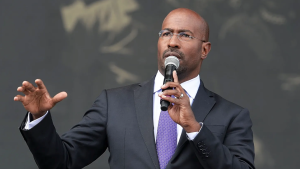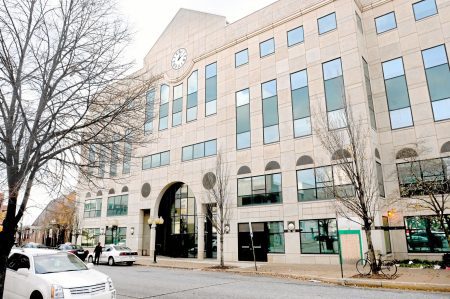By PAUL WISEMAN (AP Economics Writer)
WASHINGTON (AP) — Employers in the US added 303,000 workers to their payrolls in March, indicating that the economy can handle high interest rates without entering a recession.
In February, there were 270,000 new jobs, which exceeded economists' expectations of 200,000. This hiring spree indicates a strong economy that can handle the pressure of high borrowing costs, and employers are hiring to meet customer demand.
The unemployment rate dropped from 3.9% to 3.8%, marking the 26th straight month with a rate below 4%. Additionally, the government revised its estimate of job growth in January and February upward by 22,000.
Normally, a large number of new jobs might lead to concerns about inflation, but wage growth was mild in March. Average hourly wages increased 4.1% from a year earlier, the smallest increase since mid-2021.
As the November presidential election approaches, the economy and inflation are key concerns. Despite inflation surges, the economy has shown strong performance, which President Joe Biden claims is a result of his policies.
President Biden stated on Friday that his policies are contributing to the strong economy, and he emphasized his focus on helping the middle and working classes.
Biden's plan aims to grow the economy by investing in all Americans and providing opportunities for the middle class. He acknowledged the significant decrease in inflation but emphasized that he will continue to support hard-working families.
The economy added 303,000 jobs in March, the largest gain since May of the previous year. The average monthly job growth for this year has reached 276,000, surpassing the robust average of 251,000 in 2023.
The unemployment rate decreased even though 469,000 people entered the labor force in search of jobs in the last month, leading to a slight increase in the proportion of Americans with a job or looking for one, which can help ease inflation pressures.
While most industries added jobs in the last month, hiring was mostly in three areas: Healthcare and private education, leisure and hospitality, and government accounted for almost 69% of the hiring. Additionally, construction companies added a strong 39,000 jobs.
Four years after the pandemic limited travel and forced closures of restaurants, bars, and entertainment venues, those industries have finally reached their pre-pandemic employment level, with a category including such businesses adding 49,000 jobs in March.
The policymakers of the Fed are monitoring the state of the economy, the job market, and inflation to decide when to start reducing interest rates from their multi-decade highs. Rate cuts by the Fed would probably result, over time, in lower borrowing rates across the economy.
The central bank’s policymakers began increasing rates two years ago to try to control inflation, which by mid-2022 was at a four-decade high. Those rate hikes — 11 of them from March 2022 through July 2023 — significantly helped slow inflation. Consumer prices rose 3.2% in February from a year earlier, much lower than the peak of 9.1% in June 2022.
The much higher borrowing costs for individuals and companies that followed the Fed’s rate increases were widely anticipated to cause a recession, with waves of layoffs and a painful increase in unemployment. However, to the surprise of almost everyone, the economy has continued to grow steadily, and employers have kept hiring at a healthy pace.
Some economists think that an increase in productivity — the amount of output that workers produce per hour — made it easier for companies to hire, raise pay, and post larger profits without needing to raise prices. Furthermore, an influx of immigrants into the job market is believed to have addressed labor shortages and slowed upward pressure on wage growth. This helped reduce inflation even as the economy continued to grow.
“This report is like the macroeconomist’s Holy Grail,’’ said Julia Pollak, chief economist at the online job marketplace ZipRecruiter. “It’s pointing toward noninflationary growth.”
Observing the strong job growth, influx of new workers, declining unemployment, and slowing wage growth, Pollak stated, “It suggests that the Fed can walk and chew gum at the same time, bringing down inflation without crippling the labor market.”
In the meantime, the Fed has indicated that it anticipates reducing rates three times this year. However, it is waiting for more inflation data to gain additional confidence that annual price increases are moving toward its 2% target. Some economists have started to question whether the Fed will need to reduce rates anytime soon given the consistently resilient U.S. economy.
The ongoing strong demand for labor has resulted in some employers still struggling to fill vacancies. One of them is John Zmuda, president of Moseys Production Machinists in Anaheim, California, who said it’s still “extremely hard’’ to find workers.
Although he receives plenty of resumes, Zmuda said “it seems like most people are just wage-hunting” rather than seeking a long-term career.
Moseys, a company owned by a family that provides materials to the defense, aerospace, and healthcare industries, intends to increase its staff of 27 by hiring three or four more workers. Zmuda said he has increased wages by 10% in the past year. However, the high cost of living in California, especially for housing, discourages some potential job candidates.
Like many other manufacturers, Moseys relies heavily on robots. However, for an employer, using automation has its limitations.
“People contribute their thoughts and observation,” Zmuda said. “Robots do not. People will consider before acting.’’
Similarly, in Duncan, Oklahoma, Southern Machine Works, which also supplies the aerospace and defense industries, requires four or five machinists.
“It’s really been a challenge to find anyone,’’ said Frank Burch, CEO of the third-generation family firm.
Attracting new employees to a rural town of 23,000 is difficult, especially when the oil-field-services giant Halliburton is nearby and also recruiting workers.
“We’re simply hiring individuals who seem capable of learning the business, and then we’re training them through our internal training program,” Burch said.
Employers, he proposed, will likely have to get accustomed to tighter labor markets:
“When you look at the population makeup of the country – the baby boomers are gone, the current generation is not having many children. I just don’t really see it changing in my lifetime.’’
___









